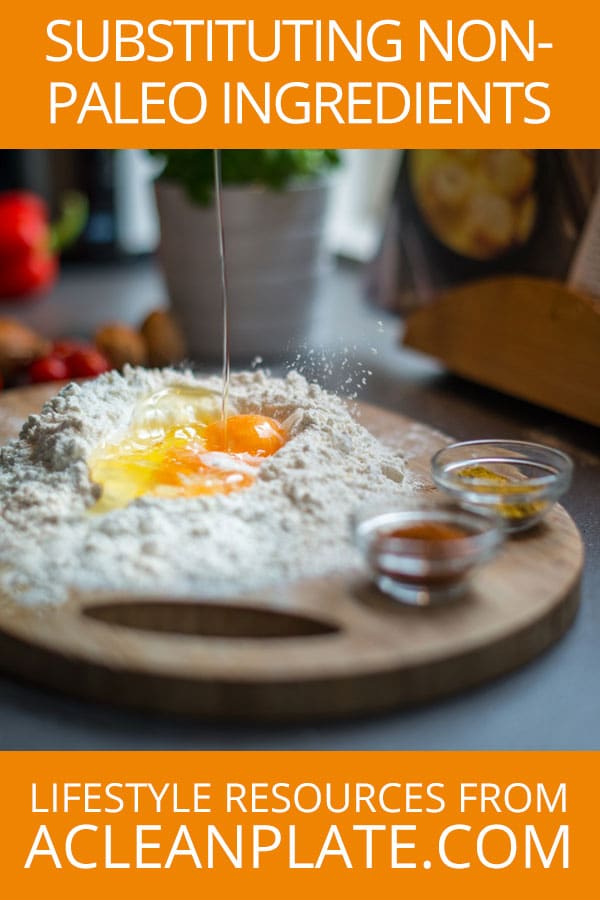Substituting Non-Paleo Ingredients in Recipes
As someone with a lot of food sensitivities who always liked to cook, I’ve had to do a lot of trial and error finding decent substitutes for a lot of foods in traditional recipes. Back when Paleo and AIP food blogs weren’t a dime a dozen, trial and error was pretty much the only option! But I’ve always enjoyed the challenge of trying to take recipes I couldn’t eat and turn them into delicious, healthy meals. With cooking, more often than not, you’re sure to find that a little trial-and-error can reap big rewards. It’s how I’ve come up with all of the recipes you can find here and in my books, and I’m no culinary genius (trust me!). To help you get started adapting all of your favorite recipes, here are some of the tricks I’ve learned for subbing non-Paleo ingredients:
Grain-Based Sides or Snacks
Traditional applications: Grains might appear as a side dish (rice, grits) or in snacks (granola, cereal, crackers).
How to sub it: Use cauliflower rice as a side dish, toasted nuts and/or seeds or coconut flakes in granola or cereal, and use plantain chips, sweet potato chips, or other veggie chips instead of chips and crackers.
Sandwiches, Burgers, or Wraps
Traditional applications: Grain-based breads (tortillas, buns, bread) may be used for wraps, burgers, and sandwiches.
How to sub it: Use lettuce leaves, portobello mushroom caps, or roasted sweet potato rounds in place of tortillas, buns, or bread for wraps, burgers, and sandwiches.
Grain Flours or Starches
Traditional applications: Grain flours and starches might appear in baked goods, as breading for meats, or in soups and sauces as thickening agents (especially as corn starch).
How to sub it: Use finely-milled blanched almond flour, hazelnut flour, chestnut flour, sunflower seed flour, pumpkin seed flour, pumpkin flour, or plantain flour 1:1 for wheat flour for baking or use up to half tapioca starch or one quarter arrowroot (with one of those flours making up the remainder), almond meal or finely-crumbled bacon for breading, and arrowroot or sweet potato starch 1:1 for corn starch as a thickening agent. Coconut flour is difficult to sub with because it is much more absorbent than other flours, but you can start by using 1/4 the amount of wheat flour called for and adding other flours or starches as needed to add bulk to the recipe. Alternatively, you can add it a teaspoon at a time to a Paleo batter you’ve made that is too wet (letting it sit for a bit to thicken before judging whether you need to add more).
Binders
Traditional applications: Gluten acts as a binder in baked goods and many gluten-free products use gums like guar or xanthan (which are not Paleo).
How to sub it: Add an extra egg or egg white; a bit of nut butter, coconut oil, or mashed banana (1/4 cup is about equivalent to one egg); flax meal or gelatin (1 tablespoon mixed with 3 tablespoons of water is about equivalent to one egg), or applesauce, plantain puree, or pumpkin puree (1/3 cup is about equivalent to one egg) to any Paleo batter that needs some extra binding to hold it together.
Sweeteners
Traditional applications: Sweeteners might appear in baking, beverages, and condiments.
How to sub it: Use evaporated cane juice (sucanat) 1:1 for white sugar, muscovado sugar or maple sugar 1:1 for brown sugar, honey instead of corn syrup, or replace 1 cup of sugar with 1 1/3 cups molasses or 3/4 cup honey or maple syrup (decreasing other liquids in the recipe by 1/4-1/3 cup to accommodate these liquid sweeteners). Make your own powdered sugar by processing evaporated cane juice until powdered and adding 1-2 tablespoons arrowroot for every cup of sugar.
Beans
Traditional applications: Beans might appear in side dishes (refried beans, 7-layer dip), entrees (chili), or dips (hummus).
How to sub it: Use 1:1 ground meat in sides and entrees and roasted root vegetables such as beets or sweet potatoes for homemade hummus.
Peanuts
Traditional applications: Peanuts might be eaten whole (like in nut mixes) or as peanut butter.
How to sub it: Use 1:1 any nut or seed for whole peanuts and almond butter, cashew butter, sunflower seed butter, or coconut butter for peanut butter.
Soy Sauce
Traditional applications: Soy sauce is frequently used in sauces or as a condiment.
How to sub it: Use 1:1 coconut aminos plus salt to taste.
Shortening and Butter (or Butter Substitutes)
Traditional applications: Butter might appear in baking or as a cooking fat.
How to sub it: Use 1:1 palm shortening or lard for baking and coconut oil, duck fat, bacon fat, or avocado oil for cooking.
Milk or Cream
Traditional applications: Milk or cream might appear in baking, novelties, soups, or condiments.
How to sub it: Use 1:1 coconut milk, homemade almond milk, or any other homemade nut- or seed-based milk.
Corn
Traditional applications: Served as a side dish (on the cob or in soups, salads), snack (popcorn), or used as a thickener (corn starch).
How to sub it: Use vegetables such as squash, carrots, sweet potatoes, or peas as a side or in soups and salads, roasted pumpkin seeds instead of popcorn, and arrowroot or sweet potato starch 1:1 for corn starch as a thickening agent.
Vegetable or Peanut Oils
Traditional applications: May appear in baking, cooking, or condiments.
How to sub it: Use 1:1 palm shortening, coconut oil, lard, duck fat, bacon fat, avocado oil, or extra virgin olive oil.
Baking Powder
Traditional applications: Baking powder is used in baking as a leavening agent.
How to sub it: For every teaspoon of baking powder, use 1/2 teaspoon cream of tartar and 1/4 tsp baking soda.
Condiments
Traditional applications: Ketchup, mustard, mayonnaise, barbecue sauce, salad dressings, relishes, chutney, horseradish, whipped cream, and vinegars are often used as condiments.
How to sub it: Make your own ketchup, mustard, mayonnaise, barbecue sauce, salad dressings, and other condiments using Paleo-friendly ingredients.
Looking for Low-Histamine Recipes?
 A low-histamine diet can be immensely helpful for MAST cell disorders or people with excess histamine production, but it’s an extremely tricky diet to manage. My e-book 28 Days of Low-Histamine AIP combines low-histamine foods with the anti-inflammatory autoimmune protocol diet in a 28-day meal plan designed to jump start and simplify your diet change. The meal plan includes 36 simple, satisfying low-histamine recipes including a variety of dishes like Chicken Schawarma, Cabbage Roll Stir-Fry, and Chimichurri Steaks. You’ll be amazed at all the flavors still available to you! The ebook is available as a digital download for $9.99.
A low-histamine diet can be immensely helpful for MAST cell disorders or people with excess histamine production, but it’s an extremely tricky diet to manage. My e-book 28 Days of Low-Histamine AIP combines low-histamine foods with the anti-inflammatory autoimmune protocol diet in a 28-day meal plan designed to jump start and simplify your diet change. The meal plan includes 36 simple, satisfying low-histamine recipes including a variety of dishes like Chicken Schawarma, Cabbage Roll Stir-Fry, and Chimichurri Steaks. You’ll be amazed at all the flavors still available to you! The ebook is available as a digital download for $9.99.


Thank you for posting these – very helpful!
Hi, i’am from Venezuela. I have been paleo for six months because i have insuline resistance (already controled) and hashimoto. But i still have problems of energy and mood swinging. With the autoinmune protocol can I improve that? Which is the ideal breakfast in autoinmune protocol to avoid the thyroid fatigue…sorry for my english and thanks!
Fatigue and mood swings can certainly be a symptom of food sensitivities, especially if your blood sugar and thyroid hormones have been regulated. It is, absolutely, worth trying because you’ll never know for sure unless you give it a shot. 🙂 The ideal breakfast contains plenty of protein and fat, just like any other meal. Soups, salads, and stir-fries are some of my favorite breakfasts.
Christina, with Thanksgiving fast approaching, I’m wondering what the best alternative to flour is for thickening sauces/gravy. I’ve heard tapioca or arrowroot are good substitutes, but I’m not sure how to use them. Would love your input! Thanks!!
Hi Danica! I’ve actually never used either of those personally, as I tend to make all of my sauces with naturally-thick coconut cream, but you can find a Paleo gravy recipe from a site and chef I trust absolutely here: http://www.thepaleomom.com/2011/12/recipe-swedish-meatballs.html. Hope that helps (and heck, maybe I’ll give it a try this year too)!
Actually, we can combine butter with coconut oil when using these ingredients as replacements for palm shortening. To replace 1 cup of palm shortening, we can use ½ cup of butter and ½ cup of coconut oil.
Sure, except butter isn’t Paleo!